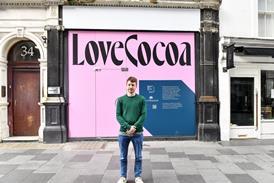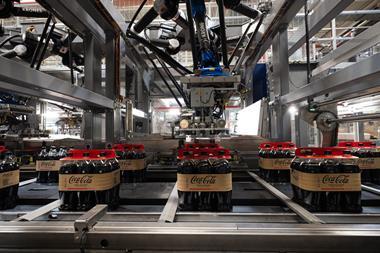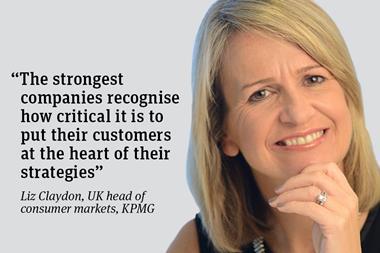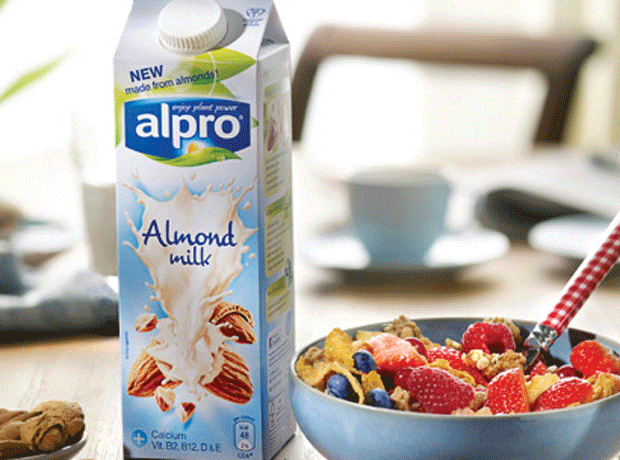A beleaguered packaging sector is fighting back, answering critics and tackling commodity hikes with innovation and continued environmental commitment. Simon Creasey reports
The packaging sector has been having a torrid time of it of late.
If it hasn't been contending with raw material cost hikes, it's been taking blows from a green lobby happy to slap even the most environmentally friendly examples ironically, while bemoaning the level of food waste (often caused by a lack of packaging). It can't win.
Or can it? While several major retailers have renewed their sustainability strategies over the past year and are now targeting greater reductions, they have also stepped up their efforts to make the packaging they do use greener and leaner. And that means we're seeing more innovative packaging hit the shelves.
"In its 2010 CSR report, Sainsbury's said it was also focusing on depot-ready packaging to remove unnecessary packaging from the supply chain," attests Andy Dawe, head of retail programmes at government waste body Wrap. "Likewise, Tesco vowed to reduce the emissions of the products it sells by 30% by 2020 and Unilever is committed to reducing the weight of packaging it uses by a third by 2020."
Reusable packaging is the holy grail but while glass also has class, the focus has switched to cheaper and more flexible alternatives.
Asda scored a hit last year with a Wrap-funded trial at five stores, which allowed customers to fill reusable pouches with fabric conditioner from a dispensing point on the shop floor.
It has been so successful that the retailer is in talks with a leading detergent brand about putting washing-up liquid in reusable pouches in its stores. Wrap, meanwhile, is talking to other retailers about the opportunities offered by reusable packaging and is due to publish a report on the trial later this month.
The benefits are not just environmental, says Steve Kelsey, strategic innovations director at branding consultancy Pi Global. "Instore refilling is a very early method of distributed manufacture [the ability to produce what you need close to where you are] that has great potential," he adds. "When it arrives it will transform many aspects of retailing and distribution."
Much of the new reusable packaging is also cheaper to produce and reducing the cost as well as the amount of packaging used is predictably a focus. Indeed, cost efficiency has started to trump functionality as a goal, as demonstrated by the increased interest in lightweighting. Companies including Coca-Cola and wine supplier Brown Brothers have already taken steps to reduce the weight of their packaging, resulting in carbon reductions and lower transport costs.
Generally though, savings from lightweighting are quite small in relation to the overall cost of the product, according to Peter Wood, sales director of CFN Packaging. You get to a point with lightweighting where it's going to cost a fortune to shave off that extra gram, he adds.
A more radical approach, such as changing the type of packaging used, might make better financial sense. This too carries risks, however, says Neil Fowell, sales and marketing director at Bapco Closures. "You could spend less and change the packaging medium but that's a brave move because you've got issues around the familiarity of the brand and its packaging," he says.
It is a lesson Cadbury learned in 2009, when it abandoned a move to switch its Roses brand from tins to cartons following an unsuccessful trial. A bid by Waitrose to switch milk from plastic cartons to pouches was also scrapped though Sainsbury's has fared well with its own efforts to do the same.
Despite such mixed results, Dev Brahmachari, sales and marketing director at CRP Print & Packaging, believes there will be more switching."We're seeing more people looking to migrate from plastic into paper packaging and that's a theme that will continue, particularly with oil prices doing what they are. The future for paper packaging looks rosy but the future for plastic packaging looks fairly grim."
Whatever material a supplier uses, clear communication with consumers is essential, says Dick Searle, chief executive of the Packaging Federation. "The first thing we need to do is start dealing with facts and telling people honestly what is important and what isn't, instead of everybody competing with each other on peripheral issues," he says. "The net result of that is that consumers end up being misled or, at best, confused."
Another industry commentator highlights one particular example he believes misleads consumers coffee being sold in 'eco refills'. Kenco launched its Eco Refills in 2009 and was last September joined by similar offerings from rival Nescafé.
Although the latter didn't flash their environmental credentials, plastic pouches in general are being touted as requiring less energy to produce than glass jars. Kenco admits that current technology means its pouches cannot be made from recycled materials, nor can the pouches be recycled in the UK, however, the company claims their introduction has brought about a 97% reduction in packaging waste.
Gillian Garside-Wight, packaging technology director at Your Packaging Partner, which advises brands and retailers on packaging strategy, believes that switching the material that a product is packaged in is a classic sleight of hand that gets the consumer to focus more on the packaging than the product.
"It's the product you're buying, not the packaging, and the overall environmental impact of the product still has to be more important," she adds. "We need to be a bit more careful as an industry about what we brand as 'green packaging'."
Legislative pressure such as the Courtauld Commitment 2, which has set aggressive reduction targets for a 2012 deadline, is ensuring waste reduction remains on the agenda. The threat of further government intervention looms large, with Defra working on a waste policy review that organisations including the FDF are feeding into. The review is due to be completed by the end of March, with a public announcement expected in May. The likely outcome will be new packaging recycling targets.
Despite such activity, Wrap has been told its budget will be slashed by 28% this year, and a further 37% over the next four years. Noises coming out of Westminster suggest the government is looking for the market supermarkets, manufacturers and packaging companies to take the lead on environmental issues.
As well as coming up with greener and more innovative packaging, they will also be expected to communicate its benefits and not just the environmental ones. "Packaging is there to protect and preserve the product. It's there to make life a bit more convenient, so that you don't have to shop every day," says Garside-Wight.
If these broader benefits can be communicated, the anti-packaging brigade will find it harder to push simplistic and often naive messages about the evils of excessive packaging in the national press, hopes Nampak business development director James Crick. "The perception is 'why do we need all of this packaging?', but the reason we have it is because we're a consumer society, which needs to deliver food with a low carbon exposure. The only way to do this is by avoiding waste, and avoiding waste means putting it in packaging."
The future of packaging
Meanwhile, packaging will continue to evolve. Experts predict greater use of RFID tags, which can be used to track and identify goods. Take-up has significantly increased in the past year, according to Mark Gillott at barcodes standards organisation GS1.
The cost of RFID tags which can be used to track and identify goods had previously been seen as prohibitive, but it has fallen over the years and Gillott claims tag suppliers are now struggling to cope with demand thanks to the likes of M&S, which, he says, will use about 180 million RFID tags this year. "They're really exploiting the technology and deriving real benefit from it."
Gillott admits it's unlikely the cost of tags will fall to the point where they will be used on mid to low-priced items sticking a 5p tag on a 50p tin of baked beans doesn't make commercial sense but perception of the cost of the tags appears to be changing. "In the past, there was a view that retailers were waiting for the price of the technology to come down so they could introduce it across the whole product range but now they can put it at different levels or ranges where it pays," he says.
In addition to intelligent packaging, grocery is also likely to see more retail-ready packaging as part of the drive to meet sustainability targets. As The Grocer reported in November, the multiples have begun a fresh push: Asda through its Chosen by You own-label offer and Sainsbury's with its revamp of Taste the Difference.
Greener packaging materials are also looming large, with food-based plastics offering particular hope, says Nampak's Crick. "We're slowly moving away from oil-based plastics to bio-based plastics made from the likes of sugar cane, for example."
He singles out Brazilian company Braskem, which has launched a carbon-reduced material made out of sugar cane. "It goes from sugar cane to ethanol and from ethanol to ethylene. The only problem is that at the moment it is cost-prohibitive," he says. But it's a definite contender in the future, agrees Searle. "In a hundred years' time you will see conventional plastics widely manufactured from waste materials," he says. "Coca-Cola is already using plants to make the materials they need."
The use of compostable materials is also expected to grow. UK-based Bioresins.eu has developed a resin that can be used for carrier bags and food packaging. The material degrades by 90% in just 180 days, so consumers can dispose of the bags in a compost heap at the end of their garden.
With innovation such as this, it's clear the industry is committed to providing effective packaging that does as little harm as possible to the environment.
It is, however, failing to communicate this clearly to consumers and it's time the sector stopped hiding its light under a bushel.
Focus On Packaging
The packaging sector has been having a torrid time of it of late.
If it hasn't been contending with raw material cost hikes, it's been taking blows from a green lobby happy to slap even the most environmentally friendly examples ironically, while bemoaning the level of food waste (often caused by a lack of packaging). It can't win.
Or can it? While several major retailers have renewed their sustainability strategies over the past year and are now targeting greater reductions, they have also stepped up their efforts to make the packaging they do use greener and leaner. And that means we're seeing more innovative packaging hit the shelves.
"In its 2010 CSR report, Sainsbury's said it was also focusing on depot-ready packaging to remove unnecessary packaging from the supply chain," attests Andy Dawe, head of retail programmes at government waste body Wrap. "Likewise, Tesco vowed to reduce the emissions of the products it sells by 30% by 2020 and Unilever is committed to reducing the weight of packaging it uses by a third by 2020."
Reusable packaging is the holy grail but while glass also has class, the focus has switched to cheaper and more flexible alternatives.
Asda scored a hit last year with a Wrap-funded trial at five stores, which allowed customers to fill reusable pouches with fabric conditioner from a dispensing point on the shop floor.
It has been so successful that the retailer is in talks with a leading detergent brand about putting washing-up liquid in reusable pouches in its stores. Wrap, meanwhile, is talking to other retailers about the opportunities offered by reusable packaging and is due to publish a report on the trial later this month.
The benefits are not just environmental, says Steve Kelsey, strategic innovations director at branding consultancy Pi Global. "Instore refilling is a very early method of distributed manufacture [the ability to produce what you need close to where you are] that has great potential," he adds. "When it arrives it will transform many aspects of retailing and distribution."
Much of the new reusable packaging is also cheaper to produce and reducing the cost as well as the amount of packaging used is predictably a focus. Indeed, cost efficiency has started to trump functionality as a goal, as demonstrated by the increased interest in lightweighting. Companies including Coca-Cola and wine supplier Brown Brothers have already taken steps to reduce the weight of their packaging, resulting in carbon reductions and lower transport costs.
Generally though, savings from lightweighting are quite small in relation to the overall cost of the product, according to Peter Wood, sales director of CFN Packaging. You get to a point with lightweighting where it's going to cost a fortune to shave off that extra gram, he adds.
A more radical approach, such as changing the type of packaging used, might make better financial sense. This too carries risks, however, says Neil Fowell, sales and marketing director at Bapco Closures. "You could spend less and change the packaging medium but that's a brave move because you've got issues around the familiarity of the brand and its packaging," he says.
It is a lesson Cadbury learned in 2009, when it abandoned a move to switch its Roses brand from tins to cartons following an unsuccessful trial. A bid by Waitrose to switch milk from plastic cartons to pouches was also scrapped though Sainsbury's has fared well with its own efforts to do the same.
Despite such mixed results, Dev Brahmachari, sales and marketing director at CRP Print & Packaging, believes there will be more switching."We're seeing more people looking to migrate from plastic into paper packaging and that's a theme that will continue, particularly with oil prices doing what they are. The future for paper packaging looks rosy but the future for plastic packaging looks fairly grim."
Whatever material a supplier uses, clear communication with consumers is essential, says Dick Searle, chief executive of the Packaging Federation. "The first thing we need to do is start dealing with facts and telling people honestly what is important and what isn't, instead of everybody competing with each other on peripheral issues," he says. "The net result of that is that consumers end up being misled or, at best, confused."
Another industry commentator highlights one particular example he believes misleads consumers coffee being sold in 'eco refills'. Kenco launched its Eco Refills in 2009 and was last September joined by similar offerings from rival Nescafé.
Although the latter didn't flash their environmental credentials, plastic pouches in general are being touted as requiring less energy to produce than glass jars. Kenco admits that current technology means its pouches cannot be made from recycled materials, nor can the pouches be recycled in the UK, however, the company claims their introduction has brought about a 97% reduction in packaging waste.
Gillian Garside-Wight, packaging technology director at Your Packaging Partner, which advises brands and retailers on packaging strategy, believes that switching the material that a product is packaged in is a classic sleight of hand that gets the consumer to focus more on the packaging than the product.
"It's the product you're buying, not the packaging, and the overall environmental impact of the product still has to be more important," she adds. "We need to be a bit more careful as an industry about what we brand as 'green packaging'."
Legislative pressure such as the Courtauld Commitment 2, which has set aggressive reduction targets for a 2012 deadline, is ensuring waste reduction remains on the agenda. The threat of further government intervention looms large, with Defra working on a waste policy review that organisations including the FDF are feeding into. The review is due to be completed by the end of March, with a public announcement expected in May. The likely outcome will be new packaging recycling targets.
Despite such activity, Wrap has been told its budget will be slashed by 28% this year, and a further 37% over the next four years. Noises coming out of Westminster suggest the government is looking for the market supermarkets, manufacturers and packaging companies to take the lead on environmental issues.
As well as coming up with greener and more innovative packaging, they will also be expected to communicate its benefits and not just the environmental ones. "Packaging is there to protect and preserve the product. It's there to make life a bit more convenient, so that you don't have to shop every day," says Garside-Wight.
If these broader benefits can be communicated, the anti-packaging brigade will find it harder to push simplistic and often naive messages about the evils of excessive packaging in the national press, hopes Nampak business development director James Crick. "The perception is 'why do we need all of this packaging?', but the reason we have it is because we're a consumer society, which needs to deliver food with a low carbon exposure. The only way to do this is by avoiding waste, and avoiding waste means putting it in packaging."
The future of packaging
Meanwhile, packaging will continue to evolve. Experts predict greater use of RFID tags, which can be used to track and identify goods. Take-up has significantly increased in the past year, according to Mark Gillott at barcodes standards organisation GS1.
The cost of RFID tags which can be used to track and identify goods had previously been seen as prohibitive, but it has fallen over the years and Gillott claims tag suppliers are now struggling to cope with demand thanks to the likes of M&S, which, he says, will use about 180 million RFID tags this year. "They're really exploiting the technology and deriving real benefit from it."
Gillott admits it's unlikely the cost of tags will fall to the point where they will be used on mid to low-priced items sticking a 5p tag on a 50p tin of baked beans doesn't make commercial sense but perception of the cost of the tags appears to be changing. "In the past, there was a view that retailers were waiting for the price of the technology to come down so they could introduce it across the whole product range but now they can put it at different levels or ranges where it pays," he says.
In addition to intelligent packaging, grocery is also likely to see more retail-ready packaging as part of the drive to meet sustainability targets. As The Grocer reported in November, the multiples have begun a fresh push: Asda through its Chosen by You own-label offer and Sainsbury's with its revamp of Taste the Difference.
Greener packaging materials are also looming large, with food-based plastics offering particular hope, says Nampak's Crick. "We're slowly moving away from oil-based plastics to bio-based plastics made from the likes of sugar cane, for example."
He singles out Brazilian company Braskem, which has launched a carbon-reduced material made out of sugar cane. "It goes from sugar cane to ethanol and from ethanol to ethylene. The only problem is that at the moment it is cost-prohibitive," he says. But it's a definite contender in the future, agrees Searle. "In a hundred years' time you will see conventional plastics widely manufactured from waste materials," he says. "Coca-Cola is already using plants to make the materials they need."
The use of compostable materials is also expected to grow. UK-based Bioresins.eu has developed a resin that can be used for carrier bags and food packaging. The material degrades by 90% in just 180 days, so consumers can dispose of the bags in a compost heap at the end of their garden.
With innovation such as this, it's clear the industry is committed to providing effective packaging that does as little harm as possible to the environment.
It is, however, failing to communicate this clearly to consumers and it's time the sector stopped hiding its light under a bushel.
Focus On Packaging









No comments yet